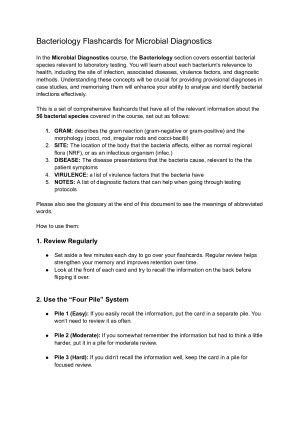Bacteriology Flashcards - Microbial Diagnostics
Subject notes for UQ 462
Description
In the Microbial Diagnostics course, the Bacteriology section covers essential bacterial species relevant to laboratory testing. You will learn about each bacterium's relevance to health, including the site of infection, associated diseases, virulence factors, and diagnostic methods. Understanding these concepts will be crucial for providing provisional diagnoses in case studies, and memorising them will enhance your ability to analyse and identify bacterial infections effectively. This is a set of comprehensive flashcards that have all of the relevant information about the 56 bacterial species covered in the course, set out as follows: GRAM: describes the gram reaction (gram-negative or gram-positive) and the morphology (cocci, rod, irregular rods and cocci-bacilli) SITE: The location of the body that the bacteria affects, either as normal regional flora (NRF), or as an infectious organism (infec.) DISEASE: The disease presentations that the bacteria cause, relevant to the the patient symptoms VIRULENCE: a list of virulence factors that the bacteria have NOTES: A list of diagnostic factors that can help when going through testing protocols
UQ
Semester 1, 2024
14 pages
2,000 words
$29.00
